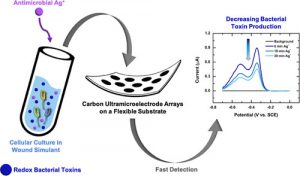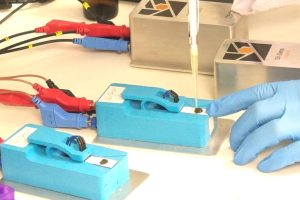
Researchers from Russian institute Skoltech and the University of Texas at Austin have created a prototype for such a sensor, and demonstrated it in a simulate wound environment where it measured three biomarkers, all of which are electro-active:
- Pyocyanin, produced a bacterium (pseudomonas aeruginosa) typically colonising chronic wounds
- Nitric oxide, secreted by the immune system in response to bacterial infections
- Uric acid, a metabolite which correlates with the severity of a wound
The proof-of-concept sensor was based on carbon ‘ultra-microelectrode’ arrays (CUAs) on PET (polyethylene terephthalate) substrate flexible substrates – previous attempts had been on ridged quartz.
Testing showed that sensor’s limits of detection and linear dynamic ranges were within the biologically relevant concentrations.
The sensor was also tried on cell cultures, where it detected pyocyanin from pseudomonas aeruginosa and nitric oxide from macrophages (immune cells).
It was also used to track the influence of silver ions, an antimicrobial agent, in the suppression of pyocyanin production by the bacteria.
“The next step is to utilise this sensor technology for in vivo studies and real-time monitoring of wound treatment effectiveness on human subjects in clinical settings,” said Skoltech provost Professor Keith Stevenson.
 Electronics Weekly Electronics Design & Components Tech News
Electronics Weekly Electronics Design & Components Tech News



